It’s Time for a New Normal on Serving Up Creative Content

People around the globe have had 14-16 weeks of getting their daily entertainment escape simply by turning on their screen, tapping into the show lists on the roster of their ad-free, ad-supported streaming services while the world goes “a little” nuts just outside their door.
With things cautiously, painfully returning to some new normal, the theater industry (and some Hollywood folks) want things to return to the old, old normal; giving them first – and extended – crack at the tentpoles, not quite tentpoles and well, yes, everything.
Or else!
A few weeks ago, we got into a Zoom thinking/learning match with Jon Peddie, president of JPR; and Kathleen Maher, EiC of TechWatch; about the current state of getting great content to people in times like this and what the future could look like.
The whole thing started on the pros/cons of NBCUniversal’s PVOD (Premium Video on Demand) OTT release of Trolls World Tour and AMC’s (big theater chain) response that they would ban the company’s future films.
Jon is a globally recognized expert in all things graphics (audio/video) and has hellaciously high standards/opinions on how content should be delivered/enjoyed.
Kathleen balances this by letting you know she knows her stuff.
Trolls isn’t something Jon would rush to see at his local cineplex (if he could).
Kathleen, on the other hand, would watch it for the technical execution
For us, it was “just a movie,” so why get your knickers knotted?
The two said that pre-lockdown there were films like the increasingly creative Star Wars series, Avatar and a few other tentpoles they had to experience on the local giant, 70mm screen with Dolby Atomos.
“Tentpoles are 1000 percent more exciting and fun watching in the theater’s balanced environment than watching them at home,” he said. “And if it’s a really epic film, we’ll do both; but first at the theater so you can realize what you’re missing.”
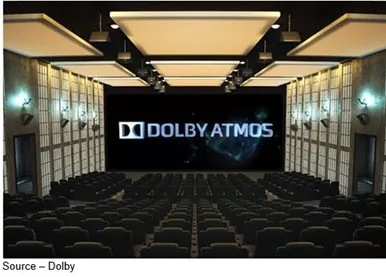
Yes, we said we had the air sucked out of our lungs and felt weightless watching Gravity during the special showing at Dolby’s Hollywood theater.
And yes, Dolby achieved their objective with the special showing … we really appreciate the elegance of their audio/video technology.
We had a similar personalized/connected experience when we left the special showing of Gone Girl.
Kathleen noted, “Sure, you can basically get the same content on your 65-in flatscreen 4K HDR OLED with 7:1 sound, but it isn’t the same as ‘being there’!”
The problem with the AMC/Universal “discussion” was that AMC had sent a letter – which they circulated everywhere – to NBCUniversal, saying their stuff would no longer be available to their theater customers.
To us, that’s a lot of bravado on AMC’s part because with 2,000 theaters closed worldwide, the company had to furlough everyone during the global shutdown.
That included CEO Adam Aron furloughing himself!
Damn, that had to hurt!
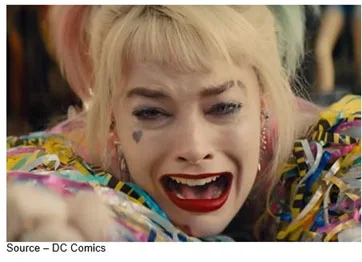
It’s a not too well-kept secret that ticket sales have been basically flat since 1964; but revenues have doubled since 1995, thanks in no small part to the expensive non-nutritional concessions.
Business couldn’t be too bad though since theater locations doubled since 1984 (20K+ to 40K+).
The standard rule – a sorta’, kinda’ gentlemen’s agreement – is that a film is first released in theaters for 90 days and when they’re through with it, the owner can release their content on DVD and VOD streaming.
There has long been push by studios and content owners to adjust the exclusive period.
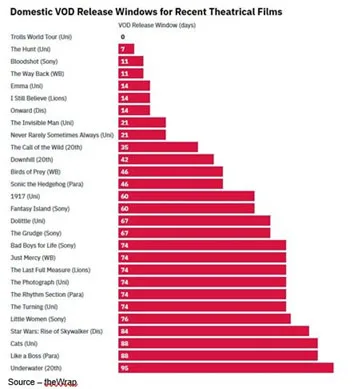
The challenge is that studios/content owners have a finite period to maximize sales and profits for their investors.
There’s nothing really wrong with the arrangement for people like Kathleen and Jon who want the complete movie experience as it was created. But for normal couples, it can pretty easily put a big dent in a 100-dollar bill for night out.
Not only did AMC theoretically slam the door on Universal, NATO (National Association of Theatre Owners) voiced their solid support.
The International Union of Cinemas (UNIC) that represents European theater associations and operators was a little nicer (professional?), saying Universal’s Troll venture was a one-off based on ultra-unusual global circumstances and wasn’t really a sign of the “new normal,” so theatrical experience would return … soon.
It’s gonna take time … lots of time.
Theaters in the U.S. are targeting early July to reopen; but when they do, will people come flooding back?
China briefly opened 500 of the 7000 screens in April to save some part of what was to be their biggest ticket-selling period of the year.
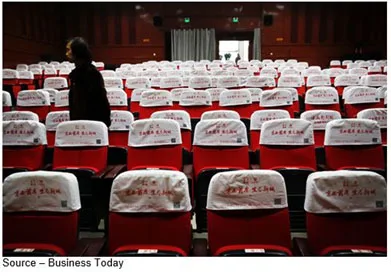
They closed in less than a week despite all of the scrubbing, safety precautions, reassurances to the public and even insanely cheap tickets.
Attendance wasn’t bad … it was pathetic.
Theaters wanted:
– Insurance against being sued by people getting sick
– Most of the gate to “help” them recover
– Studios to build events around the showing to attract more and more people
Cinemark officials have already said they believe they will be able to make deals with our studio partners to attract people back with attractive pricing.
In addition, theater chains are in discussions with landlords like the country’s largest shopping mall and retail owners for free or drastically reduced rent for a year.
The rationale is that they draw so many people into the property that they benefit other outlets and the property owner … whoopee!
We acknowledge that movie theaters are sometimes (often?) the healthiest entity in an otherwise very ill shopping mall; but guys, if people simply come for the entertainment experience and then escape as quickly as possible, it won’t be long before they abandon the entire venue.
That won’t help anyone–especially theater owners.
Kathleen noted that their local Cineplex had closed and was being torn down even before the pandemic.
In addition, when she is visiting clients in the Dallas, Ft. Worth area, she often catches a movie at an AMC theater located in a near-empty shopping mall.
It’s spooky scary but the audio/video experience is great, the environment is “good” and tickets are “reasonable.”
Getting there and leaving – even in a group – heightens the adventure.
While nothing is final, NATO members are working on detailed health precaution plans, but one member said taking patrons’ temperatures isn’t presently being considered.
I dunno guys, we know we’re okay but not certain how soon folks are willing to rush back into a dark theater with a bunch of strangers to immerse themselves with a bunch of “questionable” strangers, no matter how breathtaking it is.
Most of Hollywood’s films have been pushed back to the end of the year or even next year to get part of the $42.5B global film industry.
They still believe (and we don’t disagree) that going to a movie is really a communal experience and that people are going to come back … soon.
But Universal showed others in the industry that there is a viable option to reaching the dedicated and general interest viewer.

Trolls racked up an estimated $100M in on-demand rentals in the first three weeks, on par with the $115M domestic box office of the original.
The big difference was that the company kept roughly 80 percent of the total, compared to the typical 50/50 split with theater owners.
And the chains are talking about wanting more of the gate to help them get well?
Except in a movie script no one could have come up with a disaster like this but the theater industry has been ill for a long time, clinging to historic “rules” instead of exploring new, different solutions.
Comcast saw their market being shaved and cut away so they “adjusted.”
They acquired content folks – NBCUniversal and Europe’s Sky in addition to adding a range of customer service options.
They also went from being “the cable guy” to being the responsive customer service/support organization, which was a pleasant surprise.
They realized the marketplace was changing and no matter how uncomfortable it was, they had to reinvent themselves.
And don’t kid yourself, the success of Universal’s Trolls experiment wasn’t wasted on Disney which last year, controlled 40 percent of all box office revenue along with 60 percent of the industry’s profits.
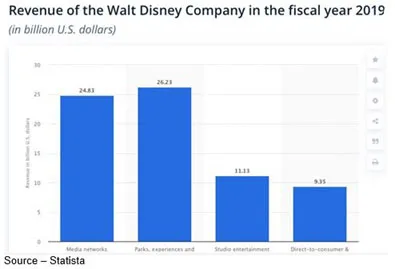
The company’s Parks group is bleeding cash and they’re right now considering a November release of the Marvel spinoff, Black Widow, starring Scarlett Johansson that cost $150-$200M to produce.
Pushing it direct to Disney +’s $6/mo. service would “cost” them a bundle.
But lots of folks who might have wanted theater experience might pony up $20 to get it first if they knew Disney wasn’t going to add it to the regular Disney + roster for 3-4 months, setting up their own theatrical window.

After all, it may be all about the glamour and mystic of Hollywood but … it’s still a business.
The global lockout hurt everyone in the M&E industry, especially the backbone of the creative content industry – the indie filmmaking creatives.
It might be time to see if the studios, content owners and distribution folks can erase the line in the sand and work out a solution that will be beneficial to everyone … including the entertainment consumer.
Yes, Kathleen – and our daughter – would prefer to experience Black Widow in a theater to savor every sight and sound as Scarlett proves what we already know … women really should run the world.
Jon would like the theater just to maximize his enjoyment of the technical creative work.
And he’d probably drop $20 to view it at home so he could really watch the movie.
Us? We’ll wait until it’s included in our Disney + bundle because we’re still watching “new stuff” we’ve never seen released in 2009!
And yes, we realize that despite this one-off year exception (streaming films will be eligible this year) films have to be shown in theaters first to be eligible for an Oscar, according to the Academy (Academy of Motion Picture Arts and Sciences) rules.
But maybe the pandemic shutdown will give them a chance to take a new look at where the creative time, money and talent investment is being made.
We don’t really understand the difference, so guess you’ll have to ask Steven Spielberg.
With nearly three months of learning good enough entertainment habits, there is no assurance that the major films that have been held for release late this year or early next year will provide the transfusion the theater industry needs to pull people back to the old normal.
 The new normal should be an opportunity for everyone in the industry to set a long-term set of goals and guidelines focused on tomorrow’s entertainment consumers.
The new normal should be an opportunity for everyone in the industry to set a long-term set of goals and guidelines focused on tomorrow’s entertainment consumers.
They are the ones the M&E industry needs to listen to and as Æon Flux said, the answer is pretty simple, “I want to remember what it feels like to be a person.”
# # #
Andy Marken – [email protected] – is an author of more than 700 articles on management, marketing, communications, industry trends in media & entertainment, consumer electronics, software and applications. He is an internationally recognized marketing/communications consultant with a broad range of technical and industry expertise especially in storage, storage management and film/video production fields. This has led to the development of an extended range of relationships with consumer, business, industry trade press, online media and industry analysts/consultants.